4 Camera Security Systems
A 4-camera security system is a surveillance setup designed to monitor and protect a specific area by utilizing four individual cameras strategically positioned to capture and record video footage. These cameras can be analog cameras, IP (Internet Protocol) cameras, or wireless cameras, each offering distinct advantages. Analog cameras convert video signals into analog format for transmission, while IP cameras digitize and transmit data over computer networks, often with advanced features like remote access and analytics.
A 4-camera security system provides comprehensive coverage of a location, enhancing security by minimizing blind spots and enabling better surveillance of entrances, exits, and critical points. These systems usually connect to a central recording device, which can be a DVR or an NVR, where video feeds are stored and managed. Depending on the system's features, users can access live or recorded footage remotely through mobile apps or web interfaces.
The system's scalability allows for additional cameras to be integrated as needed, and motion detection and notification features enhance its efficiency. Overall, a 4-camera security system serves as a robust solution for safeguarding various environments, from homes to businesses, by leveraging multiple cameras' combined monitoring capabilities.
Other Camera Systems
How far can 4 security camera systems see?
The effective viewing distance of a 4-camera security system is contingent on multiple variables, including camera specifications, environmental illumination, focal lengths of camera lenses, and resolution. Generally, security cameras can survey distances spanning several meters to potentially hundreds of meters.
Crucial factors affecting range encompass camera resolution—higher resolution yielding greater detail over extended distances— and lens focal lengths influencing zoom capability, albeit possibly narrowing the field of view.
Optimal lighting enhances distant visibility, while low-light conditions necessitate cameras with infrared (IR) or low-light technology. Camera types like PTZ (Pan-Tilt-Zoom) models offer variable zoom to focus on remote locales, bolstering range.
Transmission is pivotal—wired cameras afford steadier signal conveyance than wireless counterparts susceptible to interference. Obstructions, such as walls, can curtail effective range by obstructing line of sight.
Manufacturer-provided specifications furnish accurate insights into a system's scope. Realistically, a well-configured 4-camera security setup covers areas from tens to hundreds of feet, adaptable based on these multifaceted considerations.
What are the advantages of 4-security camera systems?
A 4-camera security system presents numerous advantages in surveillance and protection. First, it offers comprehensive coverage by strategically placing cameras to minimize blind spots and monitor key areas effectively. This arrangement enhances security, deterring potential threats.
Second, these systems facilitate advanced monitoring capabilities. Multiple cameras can be positioned to observe entrances, exits, and critical points simultaneously, ensuring a broader scope of surveillance. This aids in real-time threat detection and response.
Third, a 4-camera setup can enhance investigative capabilities by capturing multiple angles of incidents. This enables more accurate reconstructions and identification of individuals involved, assisting law enforcement and security personnel.
Fourth, scalability is a key benefit. The system can expand to accommodate additional cameras, adapting to changing security needs.
Fifth, remote access features allow users to view live or recorded footage from anywhere via mobile apps or web interfaces, bolstering convenience and oversight.
Sixth, motion detection and alert functionalities minimize the need for constant monitoring, notifying users of suspicious activity.
Finally, the integration of modern technologies like high-resolution cameras, night vision, and cloud storage furthers the system's overall effectiveness.
In essence, a 4-camera security system amalgamates surveillance efficiency, remote management, adaptability, and technological innovation to provide a robust solution for safeguarding diverse environments.
Why choose 4 security camera systems?
Opting for a 4-camera security system offers comprehensive surveillance with minimized blind spots. Strategically placed cameras ensure thorough coverage, enhancing security and threat deterrence. With multiple angles and viewpoints, these systems aid investigations and identification. They're scalable to evolving needs and often equipped with remote access, motion detection, and advanced technologies like high-resolution imaging and night vision. This choice provides an optimal balance between cost, coverage, and advanced features for effective monitoring and protection.
Is 4 security camera systems enough?
Employing a 4-camera security system can provide a level of surveillance, yet sufficiency hinges on your property's characteristics and security goals. Assess coverage range, potential blind spots, and critical areas needing monitoring. Strategically position cameras for optimal visibility and consider camera quality, resolution, and night vision capabilities. Motion detection and remote access enhance effectiveness. However, factors like property size and layout might necessitate additional cameras. Integrating alarms, sensors, and smart technology can bolster security. Regular system evaluation and updates are crucial. Engaging security experts aids in tailoring a solution that comprehensively addresses your protection needs.
-
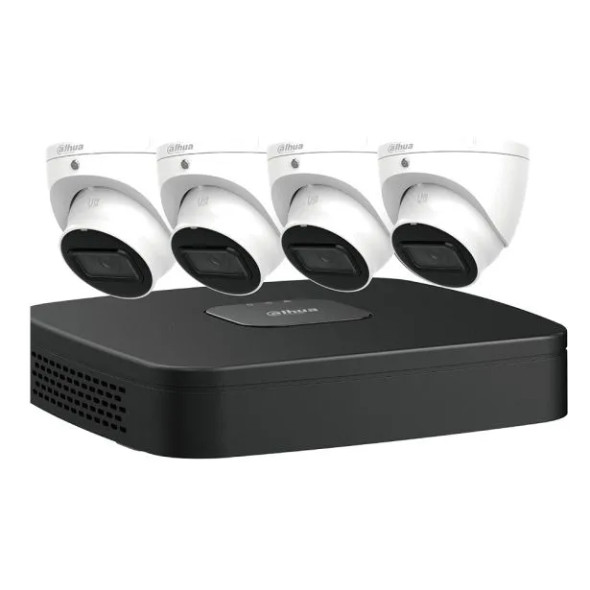
Dahua N444L42A 1x4-Channel 4K Network Video Recorder with 2TB HDD and 4x4MP Outdoor Night Vision Turret IP Security Cameras
Brand: Dahua
Part Number: N444L42A$755.99$449.75- Lens Type : Fixed Lens
- Lens Size : 2.8mm Lens
- Sensor Type : CMOS
- Sensor Size : 1/3" Sensor
- Pre-Installed Storage : 2 TB
- Hard Drive Ports : 1 SATA Port
- Protection Code : IP67
- Environmental : Outdoor
$755.99$449.75 -
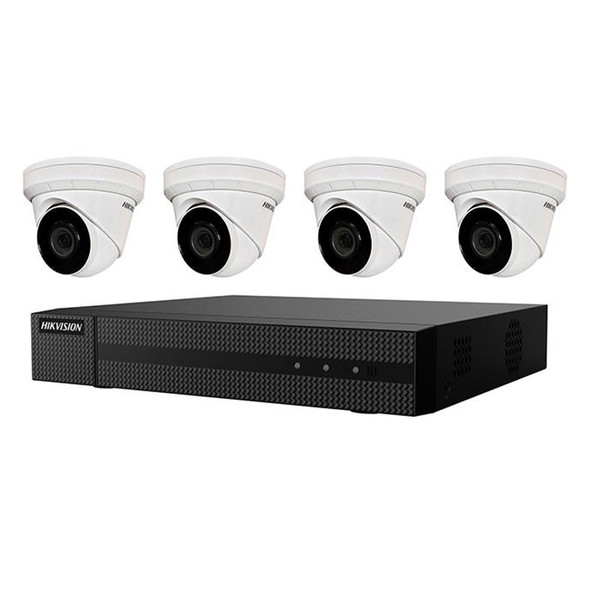
Hikvision EKI-K41T44 4-Camera IP Security Camera System, 4MP, Outdoor, Turret, 4 Channel NVR
Brand: Hikvision
Part Number: EKI-K41T44$696.90- Environmental : Outdoor
$696.90 -
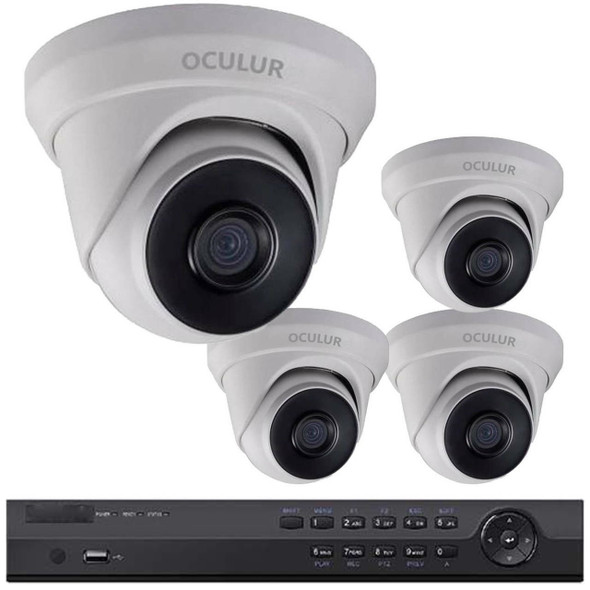
Oculur CSBS4-2TF Small Business Security Camera System - 4 x Turret Dome 4MP IP Security Cameras, Full HD Resolution, 100' Night Vision, Wide Angle View, 2-year Warranty
Brand: Oculur
Part Number: CSBS4-2TF$587.99- Lens Type : Fixed Lens
- Lens Size : 2.8mm Lens
- Pre-Installed Storage : 1 TB
- Environmental : Outdoor
$587.99 -

Speco ZIPK4N1 4 Channel Surveillance Kit with Four 5MP IP Cameras, 1TB
Brand: Speco
Part Number: ZIPK4N1$1,559.30$596.37- Lens Type : Fixed Lens
- Lens Size : 2.8mm Lens
- Pre-Installed Storage : 1 TB
- Length : 240ft
- Environmental : Indoor
$1,559.30$596.37 -

Dahua C845E42A 4 Channel 4K HD CCTV Video Recorder with 2TB HDD & 4 x 5MP Outdoor Eyeball HD CCTV Cameras
Brand: Dahua
Part Number: C845E42A$701.99$461.15- Lens Size : 2.8mm Lens
- Pre-Installed Storage : 2 TB
- Protection Code : IP67
$701.99$461.15 -

Hikvision EKI-K41B44W Wi-Fi 5-Piece Kit, (1) DS-7104NI-K1/W/M 4-Channel Wi-Fi NVR, (4) DS-2CV1041G1-IDW 4MP Outdoor IP Security Cameras, 2.8mm Lens
Brand: Hikvision
Part Number: EKI-K41B44W$632.81$627.41- Lens Type : Fixed Lens
- Lens Size : 2.8mm Lens
- Sensor Type : CMOS
- Sensor Size : 1/3" Sensor
- Video Output : 1x HDMI 1x VGA
- Hard Drive Ports : 1 SATA Port
- Max. Storage Capacity : 6 TB Storage Capacity
- Protection Code : IP66
- Environmental : Outdoor
- Aperture : F1.6
- Audio Support : Built-in Microphone
$632.81$627.41 -
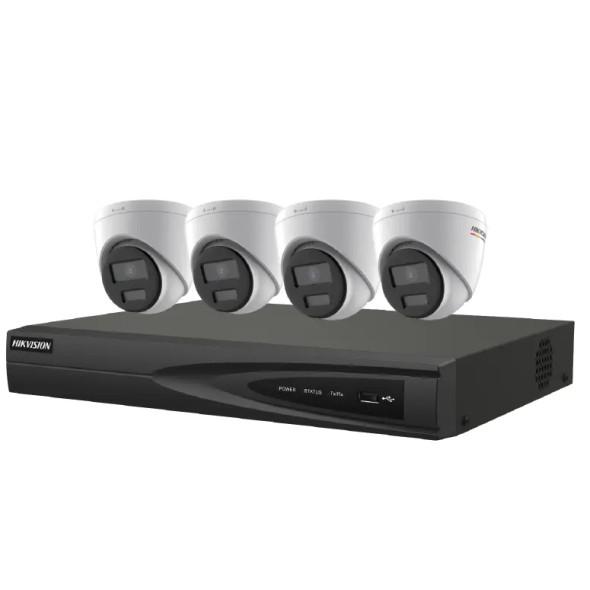
Hikvision EKI-K41T44C ColorVu 5-Piece IP Kit, (4) DS-2CD1347G2-LUF 4MP Turret Outdoor IP Security Camera, 2.8mm Lens, White, (1) ERI-K104-P4 4K 4-Channel NVR, 1TB Hard Drive Included
Brand: Hikvision
Part Number: EKI-K41T44C$835.00$632.04- Compression : H.264, H.264 Plus, H.265, H.265 Plus, MPEG4,
- Lens Type : Fixed Lens
- Lens Size : 2.8mm Lens
- Sensor Type : CMOS
- Sensor Size : 1/3" Sensor
- Pre-Installed Storage : 1 TB
- Video Output : 1x VGA 1x HDMI
- Hard Drive Ports : 1 SATA Port
- Max. Storage Capacity : 8 TB Storage Capacity
- Protection Code : IP67
- Environmental : Outdoor
- Aperture : F1.0
- Number of PoE Ports : 4 PoE Ports
- Audio Support : Built-in Microphone
$835.00$632.04 -
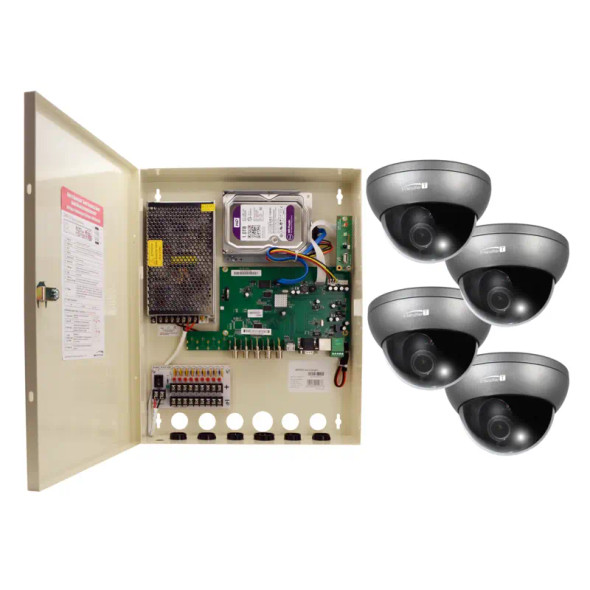
Speco ZIPTWP471 4 Camera HD CCTV Security System, 4CH Wall Mount DVR with Power Supply, 1TB, Outdoor Dome Cameras
Brand: Speco
Part Number: ZIPTWP471$879.00$824.52- Lens Type : Varifocal (Manual Zoom) Lens
- Pre-Installed Storage : 1 TB
- Environmental : Outdoor
$879.00$824.52 -
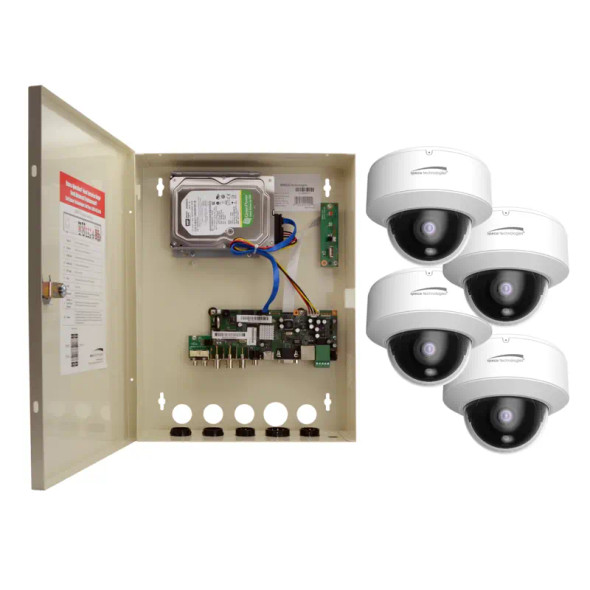
Speco ZIPTW4D1 4 Camera HD CCTV Security System, 4CH HD-TVI Wall Mount DVR, 1TB, 4 Outdoor IR Dome Cameras, 2.8mm lens
Brand: Speco
Part Number: ZIPTW4D1$1,309.30$518.27- Pre-Installed Storage : 1 TB
- Environmental : Outdoor
$1,309.30$518.27 -
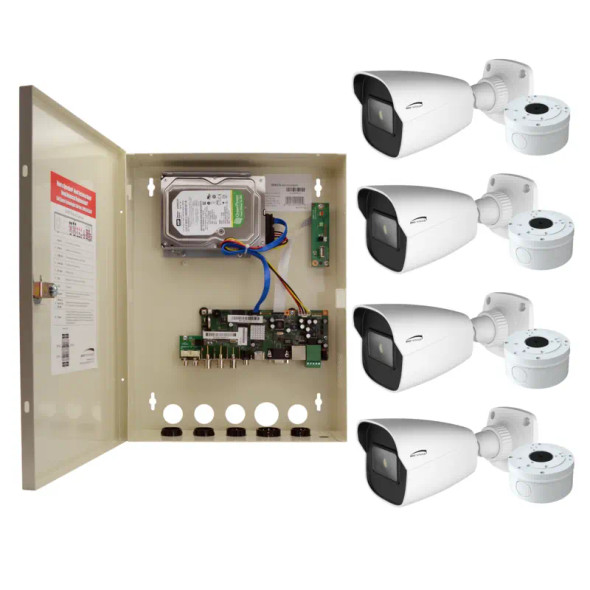
Speco ZIPTW4B1 4 Camera HD CCTV Security System, 4CH HD-TVI WALL MT DVR, 1TB, 4 IR Bullet Cameras, 2.8mm lens
Brand: Speco
Part Number: ZIPTW4B1$1,309.30$518.27- Pre-Installed Storage : 1 TB
- Environmental : Indoor
$1,309.30$518.27 -

Speco ZIPT471 4 Camera HD CCTV Security System, 4CH HD-TVI DVR, 1TB, 4 Outdoor Dome Cameras , 2.8-12mm lens
Brand: Speco
Part Number: ZIPT471$2,233.50$837.31- Environmental : Outdoor
$2,233.50$837.31 -

Hikvision T7204U1TA4C TurboHD ColorVu 5MP 5-Piece Kit, (4) DS-2CE70KF0T-MFS Turret Cameras, 2.8mm Lens, (1) iDS-7204HUHI-M1/S 4-Channel DVR, 1TB Hard Drive
Brand: Hikvision
Part Number: T7204U1TA4C$445.02- Compression : H.264, H.264 Plus, H.265, H.265 Pro, H.265 Pro Plus,
- Field of View (Horizontal) : 102°Field of View
- Max. FPS and Resolution : 8fps at 8MP
- Lens Type : Fixed Lens
- Lens Size : 2.8mm Lens
- Sensor Type : CMOS
- Pre-Installed Storage : 1 TB
- Video Output : 1x CVBS 1x HDMI 1x VGA
- Max. Recording Resolution : 8MP (4K)
- Hard Drive Ports : 1 SATA Port
- Max. Storage Capacity : 10 TB Storage Capacity
- Protection Code : IP67
- Color : Black
- Environmental : Outdoor
$445.02 -

Hikvision T7204U1TA4 TurboHD 5-Piece Kit, (1) DS-7204HUI-K1 DVR, 1TB HDD (4) DS-2CE56H0T-ITMF 5MP Outdoor Cameras
Brand: Hikvision
Part Number: T7204U1TA4$523.00$495.33- Compression : H.265, H.265 Pro Plus, H.265 Pro, H.264, H.264 Plus,
- Field of View (Horizontal) : 85.5°Field of View
- Lens Type : Fixed Lens
- Lens Size : 2.8mm Lens
- Sensor Type : CMOS
- Pre-Installed Storage : 1 TB
- Video Output : 1x VGA 1x HDMI
- Max. Recording Resolution : 8MP (4K)
- Hard Drive Ports : 1 SATA Port
- Protection Code : IP67
- Environmental : Outdoor
- Aperture : F1.2
$523.00$495.33 -

Dahua NB444E42B 4 Channel 4K Network Video Recorder with 2TB HDD & 4 x 4MP Starlight Eyeball IP Cameras, Black
Brand: Dahua
Part Number: NB444E42B$949.99$519.45- Lens Size : 2.8mm Lens
- Pre-Installed Storage : 2 TB
- Protection Code : IP67
$949.99$519.45 -
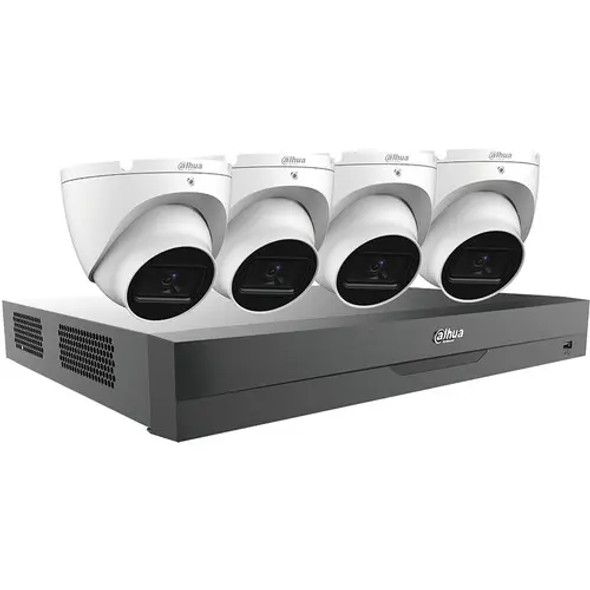
Dahua C542E42B 4 Channel 1080p HD CCTV Video Recorder with 2TB HDD & 4 x 2MP Outdoor Eyeball HD CCTV Cameras
Brand: Dahua
Part Number: C542E42B$445.99$243.21- Lens Size : 2.8mm Lens
- Pre-Installed Storage : 2 TB
- Protection Code : IP67
$445.99$243.21 -

Digital Watchdog DW-VP9T9KIT24 9 Channel 4K(8MP) Network Video Recorder with 2TB HDD & 4 x 5MP Outdoor Turret IP Cameras
Brand: Digital Watchdog
Part Number: DW-VP9T9KIT24$2,423.00$1,938.40- Lens Type : Fixed Lens
- Lens Size : 2.8mm Lens
- Sensor Type : CMOS
- Sensor Size : 1/2.7" Sensor
- Pre-Installed Storage : 2 TB
- Max. Storage Capacity : 12 TB Storage Capacity
- Protection Code : IK10 IP67
- Environmental : Outdoor
$2,423.00$1,938.40 -

Digital Watchdog DW-VP9V7BUN24 9 Channel 4K(8MP) Network Video Recorder with 2TB HDD & 4 x 2.1MP Outdoor Vandal Dome IP Cameras
Brand: Digital Watchdog
Part Number: DW-VP9V7BUN24$2,365.00$1,892.00- Lens Type : Fixed Lens
- Lens Size : 2.8mm Lens
- Sensor Type : CMOS
- Sensor Size : 1/2.9" Sensor
- Pre-Installed Storage : 2 TB
- Max. Storage Capacity : 12 TB Storage Capacity
- Protection Code : IK10 IP67
- Environmental : Outdoor
$2,365.00$1,892.00 -
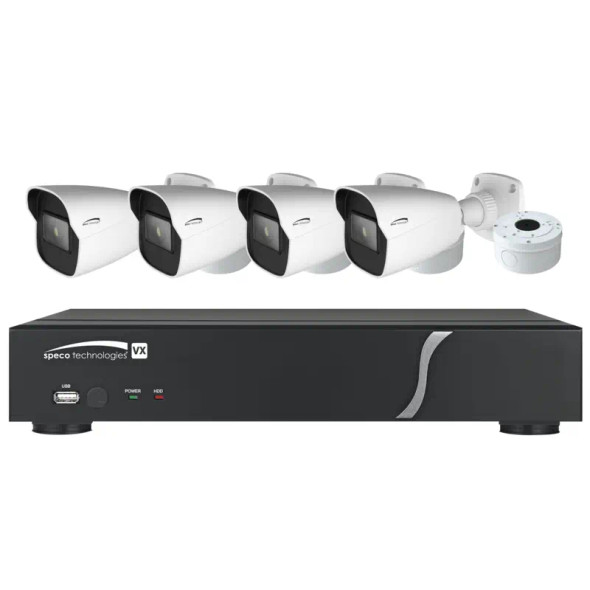
Speco ZIPT4B1 4 Camera HD CCTV Security System, 4CH HD-TVI DVR, 1TB, 4 Outdoor IR Bullet Cameras, 2.8mm lens
Brand: Speco
Part Number: ZIPT4B1$1,348.80$530.87- Environmental : Outdoor
$1,348.80$530.87 -
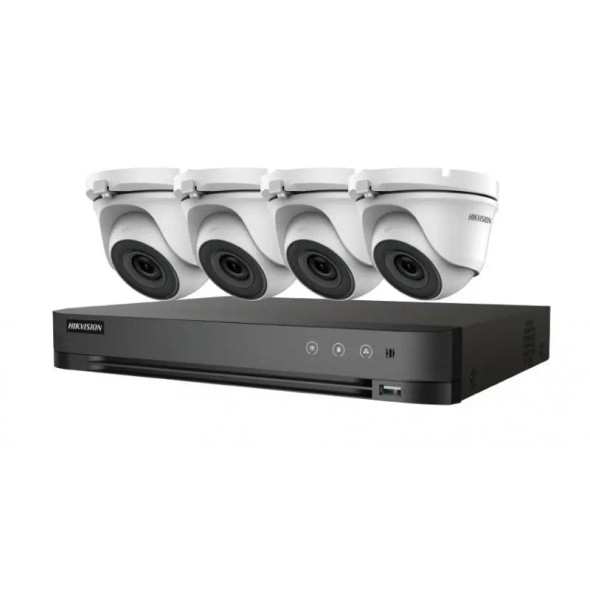
Hikvision EKT-K41T24 Value Express TurboHD 5-Piece Kit, (1) ERT-K2041 DVR, (4) ECT-T12F2 2MP Outdoor Cameras
Brand: Hikvision
Part Number: EKT-K41T24$343.93- Compression : H.264, H.264 Plus, H.265, H.265 Pro, H.265 Pro Plus,
- Field of View (Horizontal) : 103°Field of View
- Lens Type : Fixed Lens
- Lens Size : 2.8mm Lens
- Sensor Type : CMOS
- Pre-Installed Storage : 1 TB
- Video Output : 1x HDMI 1x VGA
- Max. Recording Resolution : 4MP
- Hard Drive Ports : 1 SATA Port
- Max. Storage Capacity : 10 TB Storage Capacity
- Protection Code : IP66
- Environmental : Outdoor
- Aperture : F1.2
$343.93 -
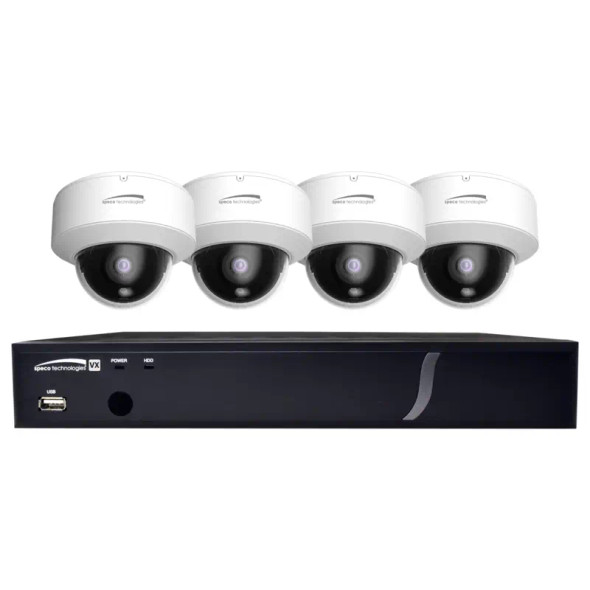
Speco ZIPT84D2 4 Camera HD CCTV Security System, 8CH HD-TVI DVR, 2TB, 4 Outdoor IR Dome Cameras, 2.8mm lens
Brand: Speco
Part Number: ZIPT84D2$819.70$752.98- Environmental : Outdoor
$819.70$752.98
